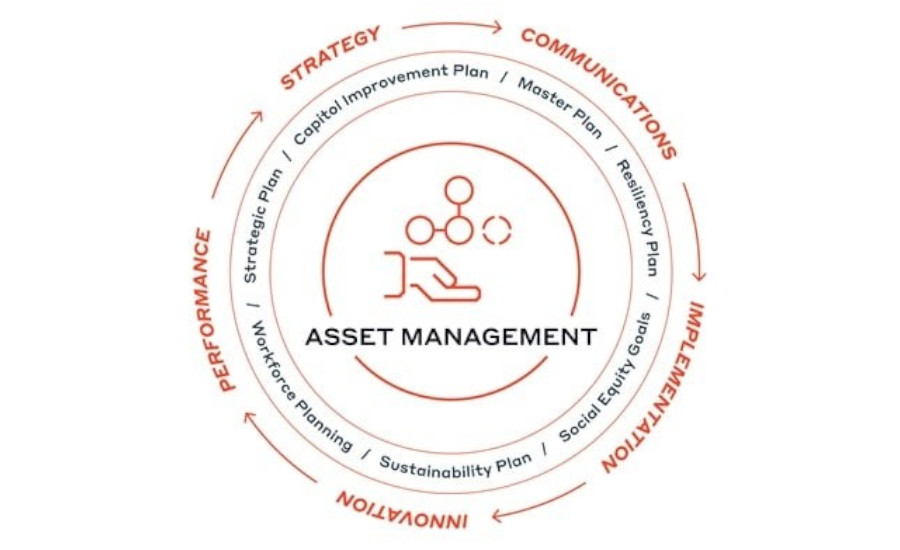Airports and other large infrastructure agencies are embedding the principles of sustainability, resilience, and equity into their asset management programs, allowing them to make more immediate and impactful changes to society and meaningfully deliver on strategic goals.
Recently, there has been greater emphasis on embedding these considerations as part of large and strategically visible capital projects by employing tools such as Leadership in Energy and Environmental Design (LEED) certification from the U.S. Green Building Council (USGBC), vulnerability analysis, and community outreach during the project planning and design process.
Organizations have realized the benefits can be much greater by applying these principles throughout the life cycle strategies of existing assets and state of good repair (SGR) projects, including operations, maintenance, renewal, and replacement decisions, which can deliver additional benefits and outcomes.
The bipartisan infrastructure law further emphasized SGR investments and are actively assessing projects based on principles of equity, resilience, and sustainability while also embedding these considerations into transportation asset management policies and funding consideration across the Federal Aviation Administration, Federal Transit Administration, and the Federal Highway Administration.
WSP has emphasized three important considerations in developing a triple bottom line (TBL) framework and philosophy for asset management that balance social, financial, and environmental outcomes:
- Align with wider goals — Incorporate goals and programs that are filtered down from statewide, citywide, and/or parent agency strategic plans;
- Incorporate TBL into decisions — Sustainability, resiliency, and equity considerations are objectively evaluated and considered in both asset and project level prioritization; and
- Promote outcomes — Maintenance and capital investments are measured through outcomes that are transparently reported and tracked.
Focusing on Implementation Outcomes
Airports have been adopting tactical approaches to incorporate sustainability, resilience, and equity into decision-making to ensure infrastructure investments are prioritized based on performance impacts and risk-reduction.
Examples of current applications and themes from the aviation sector include:
A focus on funding preventive maintenance and inspection programs, both to extend asset life and ensure asset reliability, while also delivering energy efficiencies and reduced emissions. When critical aviation facility equipment, such as fleets, HVAC systems, and wastewater and stormwater pumping stations, are under-maintained, inefficiencies and/or failures can have significant negative impacts on the environment, resilience risk, energy use, and/or greenhouse gas emissions.
- Building life cycle management plans to ensure that critical sustainability and resilience-related systems have proactive investment strategies and funding, including assets on-site solar or wind generation, water recycling systems, and wastewater pre-treatment systems.
- Explicitly linking equity outcomes to maintenance strategies with a focus on workforce development, including transit accessibility, community outreach, and local training workforce development opportunities.
- Using business cases and cost/benefit analysis to justify additional upfront costs of investments that deliver quantified TBL benefits over the long-term, including positive environmental and resilience outcomes — such as longer service life, ongoing energy and water efficiency, and environmental and social benefits for assets and systems, such as green infrastructure and zero-emission vehicles.

Project Collaboration
WSP Asset Management Advisory Services has collaborated with the firm’s aviation planning, engineering and program management teams to deliver projects across the U.S. including:

- A comprehensive asset management policy and strategic asset management plan for two large airports in the west that aligned asset management performance measures with wider sustainability and equity objectives — ensuring that investment decisions and priorities are focused on measurable outcomes;
- Strategic asset management support for a large multi-modal agency in the east (including a major airport) that incorporated social, financial and environmental outcomes into a condition, criticality and risk-based SGR prioritization approach — including evaluation of technical obsolescence and efficiency to encourage replacement of assets that result in reduced energy use and minimize environmental impacts; and
- Development of capital planning and project prioritization methodologies for several large agencies that promote dedicated funding sources to sustainability, resiliency, and equity-driven programs, such as greenhouse gas emissions reduction, renewable energy generation, and deliver service improvements and economic investment targeted toward historically underserved communities.
Incorporating asset management programs and actively aligning their wider strategic goals helps ensure optimized decisions and outcomes at each stage of the project life cycle with a specific emphasis on operations and maintenance.
As airports continue to advance their programs, asset managers should consider:
- incorporation of sustainability, resilience, and equity principles is an emerging practice, and mangers should pilot new tools and approaches that will expand and become more impactful over time as programs evolve;
- asset management data can build a strong business case for infrastructure investment based on risk and TBL impact; and
- there is significant opportunity for collaboration across sectors and agency departments as processes can be applied to all infrastructure categories and systems.
Editor’s Note: This article originally appeared in WSP’s Insights blog. See the original post in its entirety here: https://www.wsp.com/en-us/insights/2023-sustainability-resiliency-equity-in-asset-management




